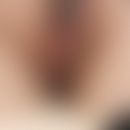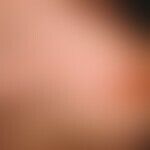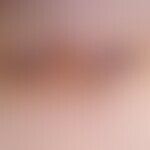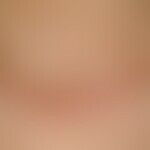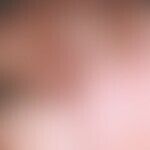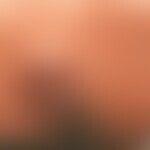General informationThis section has been translated automatically.
- If, after an excision, the skin suture line runs in the wrong direction, e.g. vertically to the relaxed skin tension lines (RSTL), wide or hypertrophic and cosmetically disturbing scarring must be expected (Fig. 1).
- The more acute the angle between the suture line and the optimal direction, the better the healing. The disturbing scarring caused by an incorrect incision is often confused with a keloid, although hypertrophy is only due to the muscle action and also occurs in patients with a real tendency for the skin to heal. Surgical errors in wound closure are caused by imprecise folding of tissue layers, especially in the vicinity of body orifices such as lips (Fig. 2 a, b), nasal entrance, eye region. If uneven wound edges of a wound are not joined together precisely, unevenness on the surface is formed. Problems often arise from a forced unification of wound edges that are under tension. Necroses with secondary infection develop in tissue sections cut off by a forced knotting of thick thread. Suture dehiscence occurs (Fig. 3). The consequence of delayed secondary wound healing is a shrinking hypertrophic rope ladder-like scarring (Fig. 4).
- Scar contracture is to be regarded as the most severe function-impairing and cosmetologically highly disturbing late consequence of a faulty technique or an unfavourable, localisation-related and/or extensive wound condition (e.g. burns, chemical burns, radiation damage) (Fig. 5). The latter can develop despite adequate tension-free defect treatment, especially in the area of the transition from the lower jaw to the neck (Fig. 6 a, b) or in the area of joint flexion. Contractures can be repaired using the technique of Z-plasty. Two interlocking triangular flaps are relocated (Fig. 7 a, b). In this way a gain in length in the common leg of the Z can be achieved. When a Z-plasty is performed to correct a contracture, the common leg lies in the direction of the contracture. The considerable tension can be eliminated by the gain in length, since the contracture diagonal is increased to the same extent as the transverse diagonal is shortened. Without an excess of skin in the transverse diagonal, however, this method would not work.
- Predilection sites for keloids are the shoulder, sternal region, auricle and neck area, but especially the neckline area of young women (Fig. 8).
- For facial incisions, the course of the branches of the facial motor nerve must be taken into account (Fig. 9). In the area marked A in Fig. 8, the nerve branch is located below the subcutaneous fatty tissue and the fascia. In zone B it runs under the muscles and in zone C directly under the platysma. Between the two dotted lines at the temple and above the zygomatic arch, the facial nerve is most vulnerable.
- In tumor excisions in the area of the inner eyelid angle, on the nasal wing and the nasolabial region as well as in the temporal region and the retroauricular region, a deep infiltration of malignant and semimalignant skin tumors must be increasingly expected (Fig. 9). In these areas, microscopically controlled surgery must not be avoided under any circumstances. Malignant cell complexes can penetrate from the inner corner of the eye via the orbital rim and the ductus nasolacrimalis to the eye and nasal cavity and via the ethmoid cells to the base of the skull. In the area of the nostril attachment and the nasolabial region there is an anatomical guide rail for the deep spread of malignant skin lesions. Tumor cones can penetrate along the mimic muscles in the fossa canina to the base of the nose and infiltrate the infraorbital foramen and the spatium buccale et infratemporale. Here, too, the tumor can penetrate to the base of the skull (Fig. 10 a-c).
LiteratureThis section has been translated automatically.
- Drepper H, Bieß B (1990) The problem of safety distance. In: AG für Krebsbekämpfung NRW (Hrsg) Kampf dem Krebs, issue 25 Schürmann & Klagges, Bochum, pp. 145-150
- Zoltan J (1977) Atlas of surgical cutting and suturing techniques. Karger, Basel Munich London



